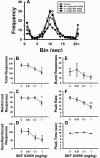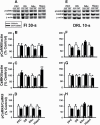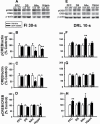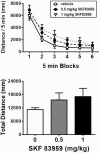Task-Dependent Effects of SKF83959 on Operant Behaviors Associated With Distinct Changes of CaMKII Signaling in Striatal Subareas
- PMID: 34049400
- PMCID: PMC8453300
- DOI: 10.1093/ijnp/pyab032
Task-Dependent Effects of SKF83959 on Operant Behaviors Associated With Distinct Changes of CaMKII Signaling in Striatal Subareas
Abstract
Background: SKF83959, an atypical dopamine (DA) D1 receptor agonist, has been used to test the functions of DA-related receptor complexes in vitro, but little is known about its impact on conditioned behavior. The present study examined the effects of SKF83959 on operant behaviors and assayed the neurochemical mechanisms involved.
Methods: Male rats were trained and maintained on either a fixed-interval 30-second (FI30) schedule or a differential reinforcement of low-rate response 10-second (DRL10) schedule of reinforcement. After drug treatment tests, western blotting assayed the protein expressions of the calcium-/calmodulin-dependent protein kinase II (CaMKII) and the transcription factor cyclic AMP response element binding protein (CREB) in tissues collected from 4 selected DA-related areas.
Results: SKF83959 disrupted the performance of FI30 and DRL10 behaviors in a dose-dependent manner by reducing the total number of responses in varying magnitudes. Moreover, the distinct profiles of the behavior altered by the drug were manifested by analyzing qualitative and quantitative measures on both tasks. Western-blot results showed that phospho-CaMKII levels decreased in the nucleus accumbens and the dorsal striatum of the drug-treated FI30 and DRL10 subjects, respectively, compared with their vehicle controls. The phospho-CREB levels decreased in the nucleus accumbens and the hippocampus of drug-treated FI30 subjects but increased in the nucleus accumbens of drug-treated DRL10 subjects.
Conclusions: Our results provide important insight into the neuropsychopharmacology of SKF83959, indicating that the drug-altered operant behavior is task dependent and related to regional-dependent changes of CaMKII-CREB signaling in the mesocorticolimbic DA systems.
Keywords: Atypical dopamine receptor agonist; dorsal striatum; neurochemical mechanism; nucleus accumbens; schedule-controlled behavior.
© The Author(s) 2021. Published by Oxford University Press on behalf of CINP.
Figures





Similar articles
-
Lack of effect of dopamine receptor blockade on SKF83959-altered operant behavior in male rats.Chin J Physiol. 2021 Jan-Feb;64(1):1-15. doi: 10.4103/CJP.CJP_92_20. Chin J Physiol. 2021. PMID: 33642339
-
Evidence for the sensitivity of operant timing behaviour to stimulation of D1 dopamine receptors.Psychopharmacology (Berl). 2007 Dec;195(2):213-22. doi: 10.1007/s00213-007-0892-y. Epub 2007 Aug 1. Psychopharmacology (Berl). 2007. PMID: 17668188
-
Relative roles of ventral striatal D1 and D2 dopamine receptors in responding with conditioned reinforcement.Psychopharmacology (Berl). 1993;110(3):355-64. doi: 10.1007/BF02251293. Psychopharmacology (Berl). 1993. PMID: 7831431
-
Motivational views of reinforcement: implications for understanding the behavioral functions of nucleus accumbens dopamine.Behav Brain Res. 2002 Dec 2;137(1-2):3-25. doi: 10.1016/s0166-4328(02)00282-6. Behav Brain Res. 2002. PMID: 12445713 Review.
-
The neuropharmacological profile of interval responding during operant tasks.Naunyn Schmiedebergs Arch Pharmacol. 2024 Oct;397(10):7551-7560. doi: 10.1007/s00210-024-03155-y. Epub 2024 May 30. Naunyn Schmiedebergs Arch Pharmacol. 2024. PMID: 38814460 Review.
References
-
- Andrianarivelo A, Saint-Jour E, Walle R, Trifilieff P, Vanhoutte P (2019) Modulation and functions of dopamine receptor heteromers in drugs of abuse-induced adaptations. Neuropharmacology 152:42–50. - PubMed
-
- Areola OO, Jadhav AL (2001) Low-level lead exposure modulates effects of quinpirole and eticlopride on response rates in a fixed-interval schedule. Pharmacol Biochem Behav 69:151–156. - PubMed
-
- Arnt J, Hyttel J, Sánchez C (1992) Partial and full dopamine D1 receptor agonists in mice and rats: relation between behavioural effects and stimulation of adenylate cyclase activity in vitro. Eur J Pharmacol 213:259–267. - PubMed
-
- Cardinal RN, Everitt BJ (2004) Neural and psychological mechanisms underlying appetitive learning: links to drug addiction. Curr Opin Neurobiol 14:156–162. - PubMed
Publication types
MeSH terms
Substances
LinkOut - more resources
Full Text Sources
Other Literature Sources

